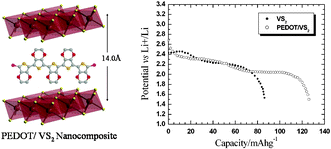Entrapment of poly(3,4-ethylenedioxythiophene) between VS2 layers to form a new organic–inorganic intercalative nanocomposite
Abstract
Here we report the synthesis and characterization of a new class of nanocomposite by direct in situ oxidative polymerization of 3,4-ethylenedioxythiophene (EDOT) with VS2 as a host material in the presence of an external oxidizing agent. Upon intercalation, the interlayer spacing of VS2 expands from 5.71 Å to 14.01 Å, followed by exfoliation and a restacking process facilitating expansion of the lattice in a direction perpendicular to the dichalcogenide layers. This change in interlayer separation is consistent with the existence of two phases of organic and inorganic species in the nanocomposites corresponding to the intercalation of PEDOT in the VS2 framework. The resulting nanocomposite is characterized by thermal analysis (TGA), X-ray diffraction, FTIR, SEM, TEM, and four-probe electrical conductivity measurements. The application potential of the nanocomposite as a cathode material for rechargeable lithium batteries is also demonstrated by the electrochemical intercalation of lithium into the PEDOT–VS2 nanocomposite, where a significant enhancement in the discharge capacity is observed (∼130 mA h g−1) compared to that (80 mA h g−1) for pristine VS2.


 Please wait while we load your content...
Please wait while we load your content...